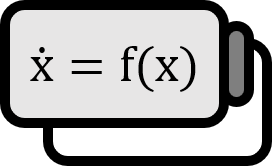Food Chain System in Dynamics
Model 1
$$ \begin{align*} \dot{R} =& R \left( 1 - {\frac{ R }{ K }} \right) - {\frac{ x_{c} y_{c} C R }{ R + R_{0} }} \\ \dot{C} =& x_{c} C \left( {\frac{ y_{c} R }{ R + R_{0} }} - 1 \right) - {\frac{ x_{p} y_{p} P C }{ C + C_{0} }} \\ \dot{P} =& x_{p} P \left( {\frac{ y_{p} C }{ C + C_{0} }} - 1 \right) \end{align*} $$
Variables
- $R(t)$: The density of resource at time $t$.
- $C(t)$: The density of consumer at time $t$.
- $P(t)$: The density of predator at time $t$.
Parameters
- $K = 0.94$: The carrying capacity of the resource.
- $x_{c} = 0.4$, $y_{c} = 1.7$, $R_{0} = 0.16129$: Values related to the consumers preying on the resource.
- $y_{p} = 5.0$, $x_{p} = 0.08$, $C_{0} = 0.5$: Values related to the predators preying on the consumers.
Description
The introduced $3$-dimensional food-chain system follows a logistic growth model for resources, and can be viewed as a coupled dynamic system of two Lotka-Volterra predator-prey models: the resource-consumer and the consumer-predator.
Typically, systems composed of such simple structures cannot be complex, but with the inclusion of a Holling Type II functional response between $R-C-P$, it becomes a chaotic system. Indeed, the bifurcation diagrams drawn by varying $K, y_{c}, y_{p}$ are as follows.

From a research standpoint, understanding such systems could add value to a paper. Although there are other examples of $3$-dimensional chaotic systems, such as the Lorenz attractor, it is too famous and overused to hold appeal as a benchmark. Moreover, as of now, it may seem less complex since it can be expressed by polynomial functions within $2$ dimensions. In contrast, the food-chain system inherently carries intuitive significance in ecology, is chaotic, and includes rational functions in its formulation, making it relatively complex 2.
Zhai, Z. M., Moradi, M., Glaz, B., Haile, M., & Lai, Y. C. (2024). Machine-learning parameter tracking with partial state observation. Physical Review Research, 6(1), 013196. https://doi.org/10.1103/PhysRevResearch.6.013196 ↩︎
Moradi, M., Panahi, S., Bollt, E. M., & Lai, Y. C. (2024). Data-driven model discovery with Kolmogorov-Arnold networks. arXiv preprint arXiv:2409.15167. https://doi.org/10.48550/arXiv.2409.15167 ↩︎
